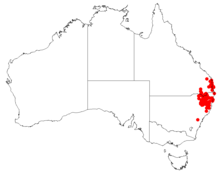Persoonia cornifolia
Persoonia cornifolia is a plant in the family Proteaceae and is endemic to eastern Australia. It is a shrub with elliptic to egg-shaped leaves and hairy yellow flowers, and grows in northern New South Wales and south-eastern Queensland.
| Persoonia cornifolia | |
|---|---|
 | |
| Persoonia cornifolia flower | |
| Scientific classification | |
| Kingdom: | Plantae |
| Clade: | Tracheophytes |
| Clade: | Angiosperms |
| Clade: | Eudicots |
| Order: | Proteales |
| Family: | Proteaceae |
| Genus: | Persoonia |
| Species: | P. cornifolia |
| Binomial name | |
| Persoonia cornifolia | |
 | |
| Occurrence data downloaded from AVH | |
| Synonyms[1] | |
| |
Description
Persoonia cornifolia is an erect or spreading shrub with hairy young growth. The leaves are elliptic to egg-shaped, 20–80 mm (0.8–3 in) long, 10–45 mm (0.4–2 in) wide and flat with the edges more or less turned downwards. The leaves are hairy when young but become glabrous with age. The flowers are arranged in small groups in leaf axils with a scale leaf at the base of each flower. Each flower is on the end of a densely hairy pedicel 1–2 mm (0.04–0.08 in) long. The flower is composed of four hairy tepals 10–13 mm (0.4–0.5 in) long, which are fused at the base but with the tips rolled back. The central style is surrounded by four yellow anthers which are also joined at the base with the tips rolled back, so that it resembles a cross when viewed end-on. The ovary is usually hairy. Flowering occurs from December to February and is followed by fruit which are green drupes.[2][3]
Taxonomy and naming
Persoonia cornifolia was first formally described in 1830 by Robert Brown from an unpublished manuscript by Allan Cunningham. Brown's description was published in Supplementum primum Prodromi florae Novae Hollandiae.[4][5]
The specific epithet (cornifolia) is derived from the Latin words cornu meaning "horn"[6]:421 and folium meaning "leaf".[6]:340
Distribution and habitat
This persoonia grows in woodland and forest north from the Moonbi Range in north-eastern New South Wales and in south-eastern Queensland.[2][7]
 Fruit and foliage of Persoonia cornifolia
Fruit and foliage of Persoonia cornifolia Persoonia cornifolia growing near Cathedral Rock National Park
Persoonia cornifolia growing near Cathedral Rock National Park Hairy ovary of Persoonia cornifolia
Hairy ovary of Persoonia cornifolia
References
- "Persoonia cornifolia". Australian Plant Census. Retrieved 16 July 2019.
- Weston, Peter. "Persoonia cornifolia". Royal Botanic Garden Sydney. Retrieved 19 December 2017.
- Weston, Peter. "Persoonia". Royal Botanic Garden Sydney. Retrieved 20 December 2017.
- "Persoonia cornifolia A.Cunn. ex R.Br". Australian Plant Name Index (APNI), IBIS database. Centre for Plant Biodiversity Research, Australian Government.
- Brown, Robert (1830). Supplementum primum prodromi florae Novae Hollandiae:. London. p. 16. Retrieved 19 December 2017.
- Brown, Roland Wilbur (1956). The Composition of Scientific Words. Washington, D.C.: Smithsonian Institution Press.
- "Persoonia cornifolia". Atlas of Living Australia. Retrieved 20 December 2017.